Smilax Vines in Central Florida
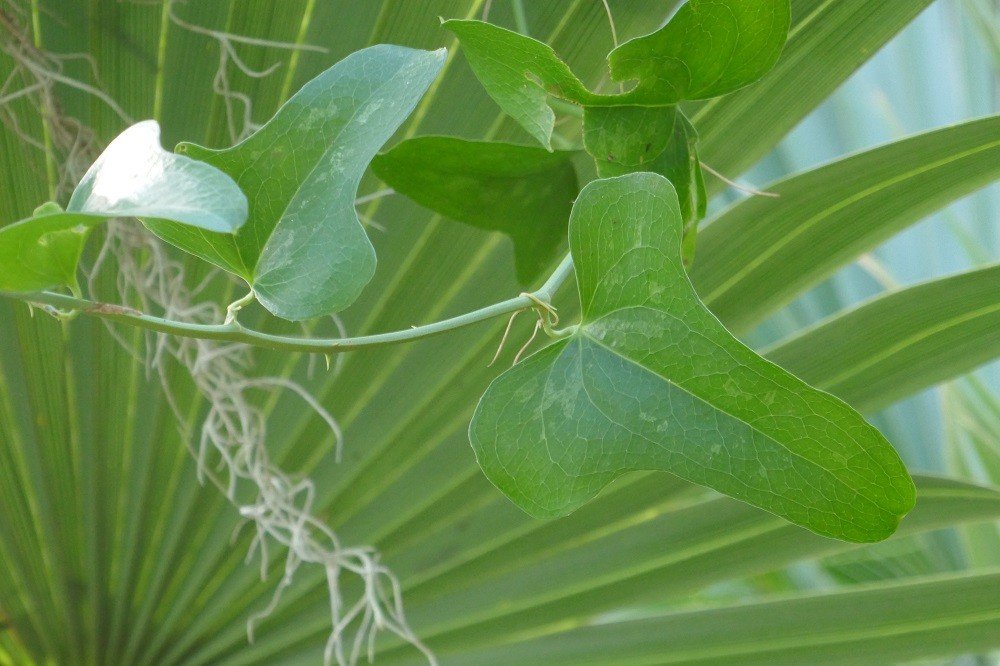
Smilax is an important native vine with many uses for those who like to create wildlife habitat and landscape with edibles. Some people, however, dislike Smilax as the vine often becomes a tangled mess of thorns without benefit of any showy flowers.
Smilax goes by many common names which can be confusing. It is most often called greenbrier, but is also called catbrier, sarsaparilla vine, prickly-ivy, bull brier, deer thorns, and hog brier. Several of the north Florida species are called carrionflower.
Smilax vines are dioecious, which means the female flowers grow on female plants and the male flowers grow on male plants. So only female vines will produce fruit.
Twelve species of Smilax are documented as native to Florida and this article focuses on the eight that are found naturally occurring in central Florida.
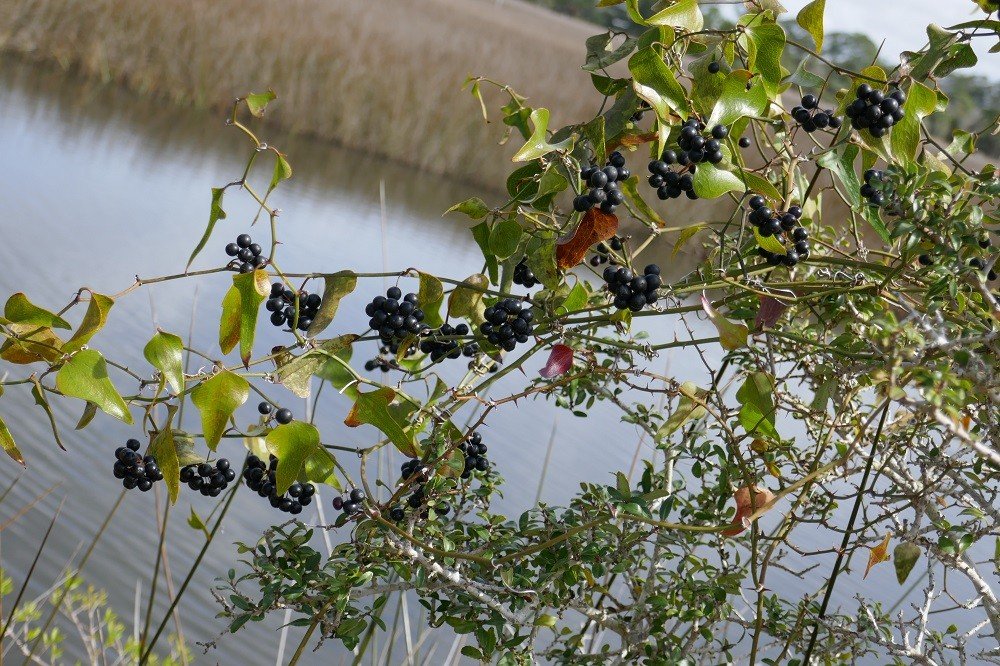
Smilax as a food source is invaluable to some of our wildlife. Florida’s fish crow relies on the berries almost exclusively as a food source and for white tailed deer, the foliage and stems rate as one of its most important food sources. [1] Wild turkey and wood ducks eat the fruit, foliage, flowers and tender new leaves. Smilax berries are an important food for a wide variety of songbirds including cardinals, catbirds, mockingbirds, sparrows, thrashers, and woodpeckers. Florida mammals that consume the ripe berries include opossums, raccoons, squirrels, bears, woodrats, and rabbits. The same wildlife also consume the new growing shoots, leaves and flowers.
Once Smilax becomes a tangled mat of vines, its thorns provide excellent cover for wildlife. If allowed to grow naturally in the home landscape, small mammals and songbirds will frequently utilize its structure as temporary escape from predators.
Songbirds occasionally nest in smilax vine when conditions are just right. For this to happen, Smilax must be located in an out of the way, protected area with an access route they have established which is free from thorns that would otherwise catch their wings. If the vine is located next to a large tree frequented by raccoons or other predators, or is located too close to regular human foot traffic, it will be avoided by the songbirds for nesting, but sometimes the conditions are just right and it becomes a valuable nesting location.
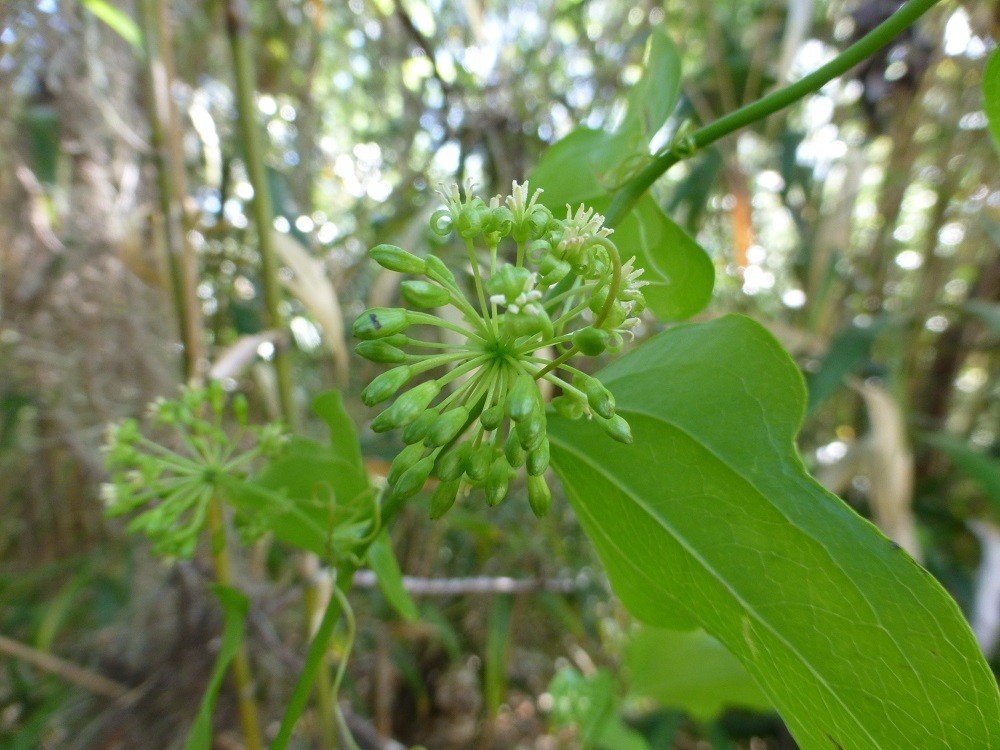
Smilax can be grown in the home landscape without the thorns being too annoying if tended by regular pruning, however it is best in a natural setting where it can ramble and find its own shape and dimensions. Smilax eventually sends out underground shoots as it matures so even if it is trellised and trained it will still need regular maintenance to keep it in bounds. It can be grown at the base of a tree and allowed to climb into the canopy with the lower foliage being kept trimmed where people and pets won’t get tangled in it. If only one or two main stems are maintained, they can be attached to the tree with a trellis, or bracket, and the majority of the thorny foliage can be kept above head height.
Smilax vines grows in a variety of conditions from wet to dry, but is usually found in hammocks and forests. Of the twelve species native to Florida three don’t have thorns, Smilax ecirrhata (upright carrionflower), Smilax lasioneuron (Blueridge carrionflower) and Smilax pumila (sarsaparilla vine). Smilax ecirrhata and Smilax lasioneuron are considered rare and are found in only a few counties in north Florida near the Georgia border.
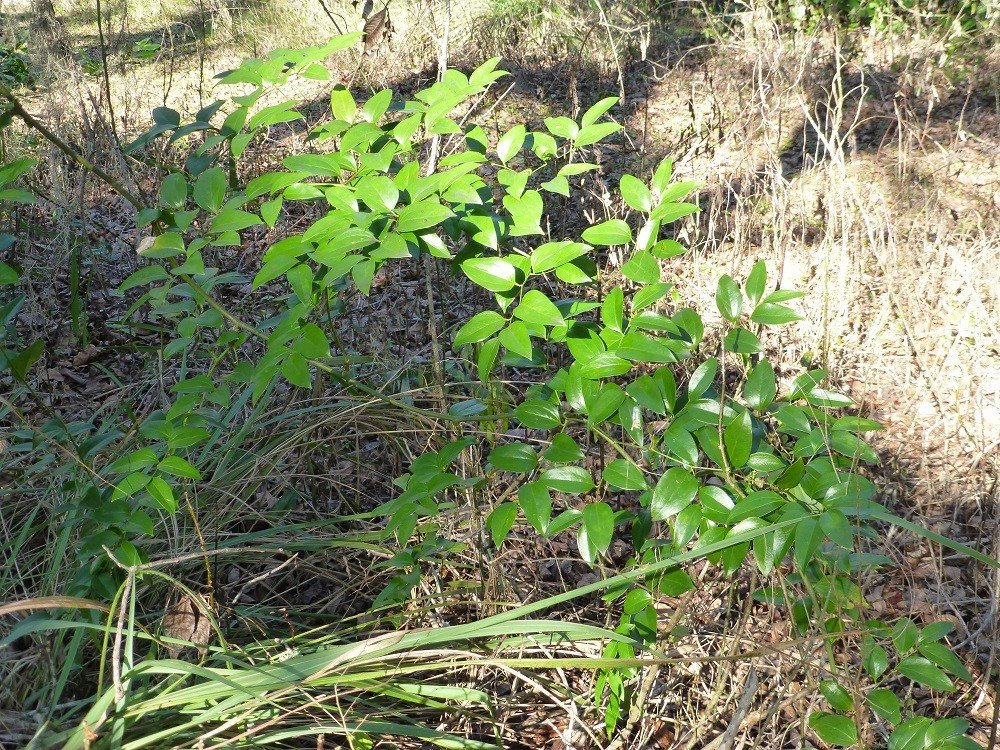
Every Smilax species grows in hammocks or forests. Hammocks, and forests, are generally categorized by their moisture levels. In general, hammocks and forests are divided into three categories: dry (xeric), medium (mesic) and moist (hydric). The term hammock doesn’t appear in every dictionary and very well may be a regional term used in the southeast. Hammock appears to be bastardized from the word hummock, which means a low mound of earth. I’m from the south and have always used the term hammock, but it may be best for my readers to use the word ‘forest’ since it is a more commonly used word.
The roots of the Smilax species mature into large, water retaining, rhizomes. In dry (xeric) hammocks (forests) the rhizomes become quite large and can grow as large as a basketball which gives the plant the ability to survive harsh conditions and long periods without rain. Another survival technique the roots develop is the production of smaller rhizomes along their underground stems. Each one of these sections of rhizome will send up a new vine, which, once established, makes digging up and moving the plant tedious and labor intensive. Smilax is very drought tolerant and needs little care or maintenance other than optional trimming.
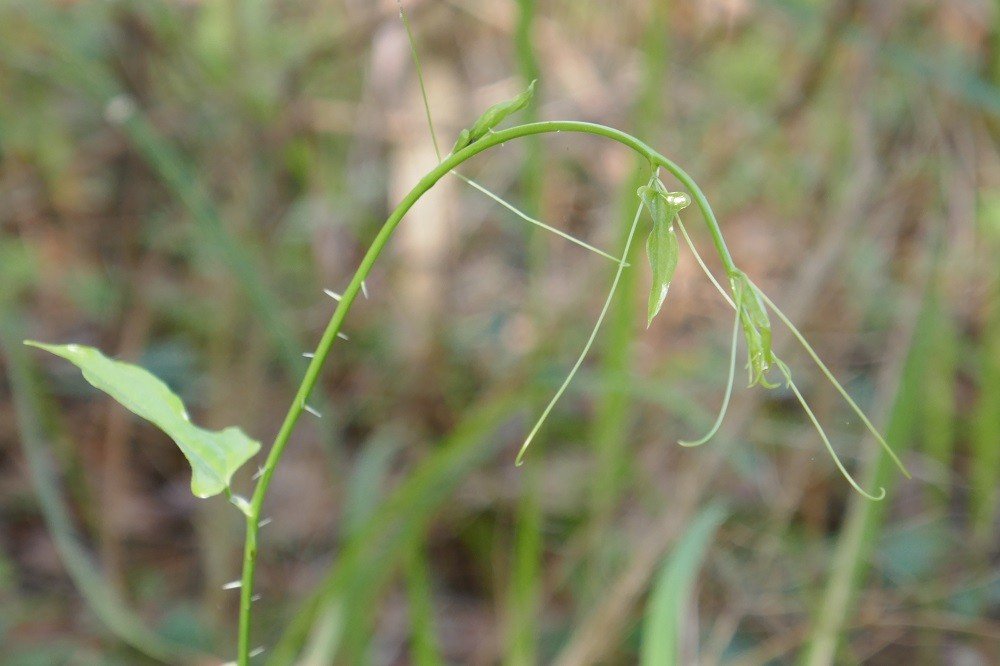
Smilax grows in the part shade of forests and sends out its vines into patches of sunlight for photosynthesis. Therefore, in the wild, some parts of the plant can be found in sun and some in shade. Various species grow in xeric forests and some in mesic forests and except for a couple of species, most are very similar in appearance. The two species in central Florida that quite distinctive from the others are Smilax pumila (sarsaparilla vine), which has thin, papery, leaves and grows laterally along the forest floor, and Smilax walteri (coral greenbrier) which is the only one documented for wetlands with red berries.
The only edible part of the Smilax vines is the new growth of the leaves and stems. New growth appears only if the vines are trimmed regularly. Smilax berries are not edible. If you are lucky enough to have a field of Smilax that is mowed regularly you will be able to harvest large quantities, but for the most part very little new growth will be found at one time. Foraging in the forest will offer only tips of new growth here and there, but when you do find them they are a delicious treat. In order to make a recipe that involves a few cups of edible foliage some planning is required, and by collecting a handful at a time and placing them in your freezer, you eventually acquire enough for a meal. Actually a handful can be utilized daily in salads or as a potherb added to scrambled eggs like you would add spinach. Since the new growth is very tender, gentle cooking is required; usually a brief stir fry or steam is all that is needed. If you add Smilax greens to a soup it should be done in the last few minutes so it doesn’t get overcooked. Adding to a soufflé or quiche, the greens can be cooked briefly to soften them slightly before incorporating into the recipe, but be sure to drain on paper towels to remove any excess moisture.
Smilax can be propagated by transplanting rhizomes, rooting semi-hardwood and softwood cuttings, or growing it from seeds. The germination rate with seeds is usually around 50% and they need to be put through a simulation of natural seasons so they need several months of cold stratification followed by several months of warm stratification.
Smilax auriculata (earleaf greenbrier)

Habitat: Sandhills, flatwoods, hammocks (forests), thickets, and sandy sites
Leaves: Evergreen, simple, alternate, entire, and oblong in shape. Some leaves are variable and may have widened bases. Leaf size is generally 3-12 cm long and 1-5 cm wide. Both leaf surfaces are green.
Flowers: Clusters of small greenish-yellow flowers appear in the summer.
Fruit: Clusters of fruit that mature from reddish to purplish-black. The fruit is 6-13 mm in size with a whitish cast (glaucous).
Region: Smilax auriculata is a common greenbrier found throughout the state from north Florida south into the Keys.
Features: The leaf margins have veins very close together forming a groove and lower stems may have a pinkish coloration to them.
Smilax bona-nox (saw greenbrier)

Habitat: Mesic hammocks (forests) and thickets.
Leaves: Semi-evergreen, simple, alternate, entire, ovate to fiddle shaped. Leaf size is 5-14 cm long and 1-12 cm wide. The upper leaf surface is shiny green and the lower is paler. Some leaf bases may be heart shaped.
Flowers: Clusters of small white flowers appear in the spring.
Fruit: The clusters of fruit mature into dark, purplish-black, berries that are 6-8 mm in size.
Regions: Smilax bona-nox is a common greenbrier found from north Florida south into the Keys.
Features: The leaf margins may have small prickles and the lower stems have brown, rough, scales (scurfy).
Smilax glauca (cat greenbrier)

Habitat: Sandhills, flatwoods and hammocks (forests).
Leaves: Semi-evergreen, simple, alternate, entire, ovate in shape with the upper leaf surface green and the lower with a whitish cast (glaucous). Leaf size is 4-10 cm in length.
Flowers: Clusters of small greenish white flowers appear in the spring.
Fruit: The clusters of fruit mature into dark, purplish-black, berries that are 6-8 mm in size and have a whitish cast to them (glaucous).
Regions: Smilax glauca is a frequent greenbrier found from north Florida south to Sarasota County.
Features: The whitish coating (glaucous) on the lower leaf surface of the leaves is a distinguishing feature.
Smilax laurifolia (bamboo vine)

Habitat: Mesic hammocks (forests) and swamps.
Leaves: Evergreen, simple, alternate, entire, oblong to lance shaped. Leaf size is 5-15 cm in length. The central mid-vein, or rib, is prominently raised and the lateral veins coming off of it are not.
Flowers: Clusters of small greenish white flowers appear in late spring and summer.
Fruit: The clusters of fruit mature into shiny, purple-black berries that are 5-8 mm in size.
Regions: Smilax laurifolia is a common greenbrier found from north Florida south to Miami-Dade County, but not the Keys.
Features: The raised central mid-vein is a distinguishing feature.
Smilax pumila (sarsaparilla vine)
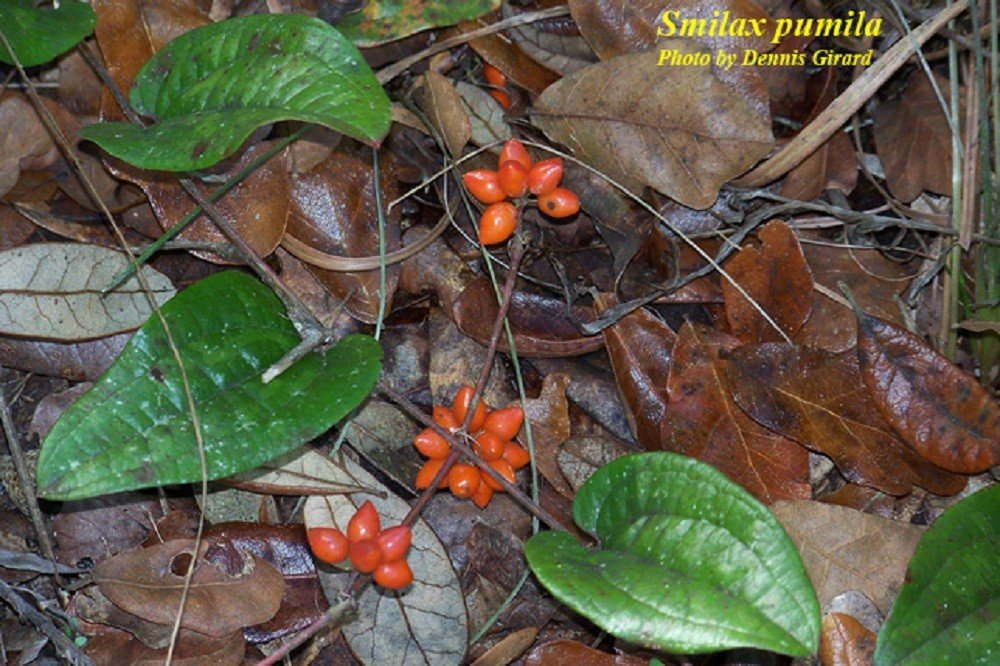
Habitat: Mesic and xeric hammocks (forests) and scrub.
Leaves: The leaves are papery (chartaceous), simple, entire, ovate to oblong in shape. Leaf size is 4-10 cm long and 3-5 cm wide. Many leaf bases are heart shaped (cordate). The upper leaf surface is dark green and the lower surface is pubescent with grayish hairs.
Flowers: Clusters of small greenish flowers appear in the spring, summer and fall.
Fruit: The berries are red with a tapering point.
Regions: Smilax pumila is a common greenbrier found from north florida south to Sarasota county.
Features: Paper leaves (chartaceous), red fruit, and its habit to sprawl along the forest floor distinguish this Smilax from all the others.
Smilax smallii (lanceleaf greenbrier)

Habitat: Hammocks (forests).
Leaves: Evergreen, simple, alternate, entire, lanceolate, 4-10 cm long and 1-3 cm wide. The upper leaf surface is a paler green than the lower. The leaf tips (apices) taper to a point.
Flowers: Clusters of small greenish-yellow flowers appear in the summer.
Fruit: The berries are a dark reddish-brown in color with a white cast (glaucous). Sizes range from 5-8 mm.
Regions: Smilax smallii is frequently found from north Florida south to Highlands County.
Features: The lanceolate leaves and glaucous berries set this Smilax apart from the others. Fresh foliage has red stems (petioles).
Smilax tamnoides (bristly greenbrier)
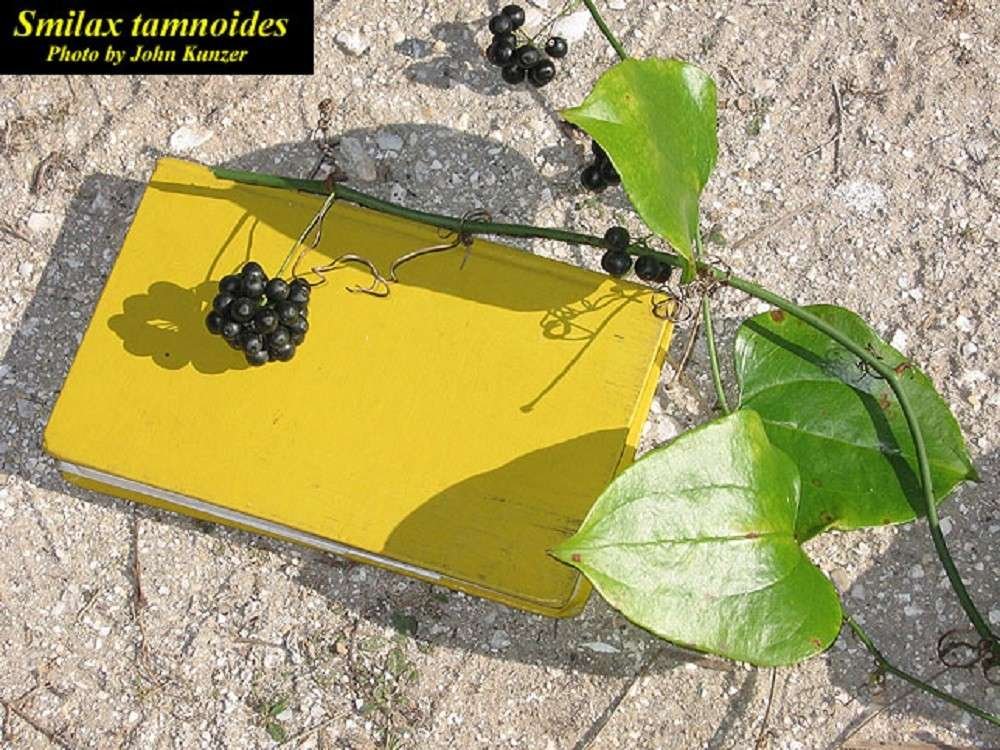
Habitat: Mesic hammocks (forests).
Leaves: Semi-evergreen, simple, alternate, with finely toothed leaf margins (erose) which are generally only seen upon magnification. The leaves are ovate in shape and measure 5-15 cm long.
Flowers: Clusters of small greenish flowers appear in the spring. The flower stalks (peduncles) are 1 ½ times longer than the leaf petioles.
Fruit: Clusters of purple-black berries are 6-8 mm in size and have long stalks.
Regions: Smilax tamnoides is occasionally found from north Florida south to Collier County.
Features: The distinguishing features of this Smilax are the black needle like thorns and long flower stalks (peduncles).
Smilax walteri (coral greenbrier)
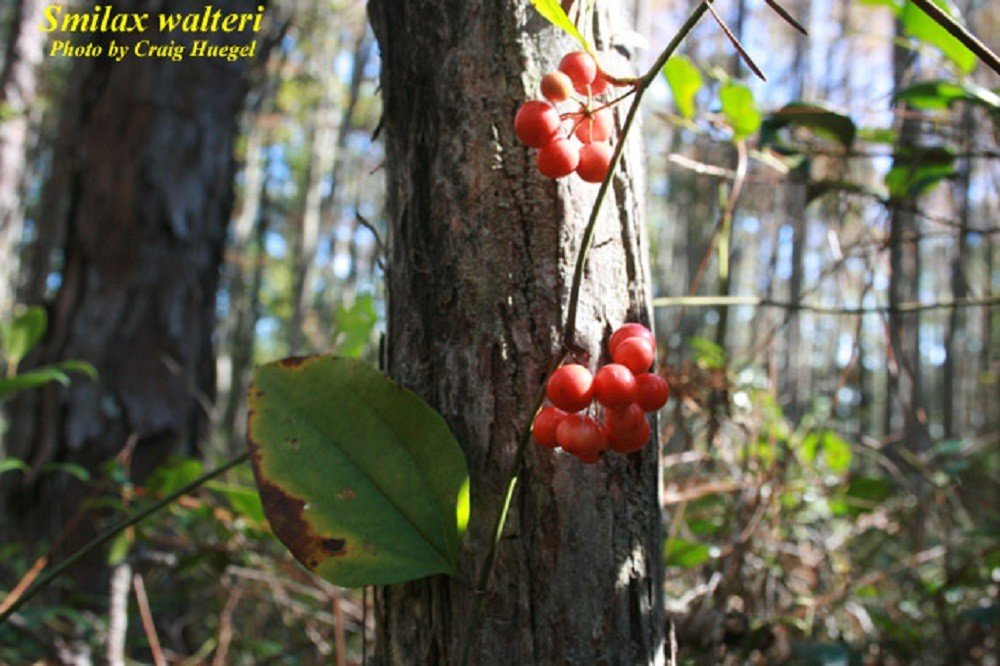
Habitat: Marshes, swamps, mesic hammocks (forests) and floodplains.
Leaves: Deciduous, simple, alternate and entire. The mature leaves are ovate and new leaves tend to be oblong. Leaf sizes range from 4-14 cm long and 2-6 cm wide. Leaf bases may be round to truncate.
Flowers: Clusters of small greenish flowers appear in the spring.
Fruit: The coral red berries are 6-8 mm in size and are predominant on the vine when the leaves have fallen in fall and winter.
Regions: Smilax walteri is frequently found from north Florida south to Glades County.
Features: The features that distinguish this Smilax from the others are the coral red berries, deciduous leaves, and the fact that it grows in wetland habitats.
Footnote:
[1] Martin, Alexander C. et al. American Wildlife and Plants: a Guide to Wildlife Food Habits. Dover Publishing. 1951. (Amazon Assoc. link)
Atlas of Florida Plants. Institute for Systemic Botany Smilax species
